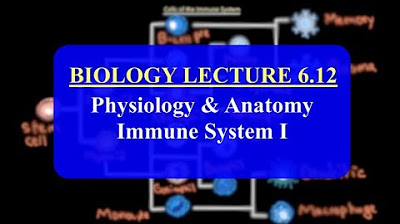Types of Immune Cells Part 1: Immune Cell Function
Summary
TLDRThis video introduces the immune system, focusing on the major cell types and their functions. The immune system, unlike other body systems, relies on billions of mobile white blood cells circulating through the bloodstream and tissues to detect and respond to threats. The video outlines four key functions of immune cells: recognizing threats, reacting with effector functions, regulating immune responses to prevent damage, and remembering past infections for future defense. The dynamic and complex nature of the immune system will be explored in greater detail throughout the series.
Takeaways
- 😀 The immune system consists of various cell types that perform specific functions in defending the body against threats.
- 😀 Unlike fixed organs in other systems, immune cells are mobile and circulate through the bloodstream and tissues to patrol for threats.
- 😀 Immune cells detect and respond to signs of infection, tissue damage, and cancer through chemical signals.
- 😀 Immune cells have four main functions: recognize, react, regulate, and remember.
- 😀 'Recognize' refers to the ability of immune cells to distinguish between self and non-self cells, and to identify infected or cancerous cells.
- 😀 'React' involves immune cells deploying effector functions, like killing pathogens or infected cells, and coordinating the immune response.
- 😀 'Regulate' ensures that immune cells do not cause damage to healthy tissue by controlling overactive immune responses.
- 😀 Immune cell activation requires signals indicating the presence of pathogens and 'co-stimulatory signals' to ensure appropriate responses.
- 😀 Immune cells release cytokines and chemokines to communicate with each other, guiding the immune response and tissue repair.
- 😀 'Remember' refers to the ability of T and B lymphocytes to recall previous threats, which is the basis for vaccinations and immune memory.
- 😀 The spatial distribution of immune cells in the body, particularly in lymphoid tissues, plays a key role in how immune responses are carried out.
Q & A
What is the primary function of the immune system?
-The primary function of the immune system is to protect the body from threats such as infections, tissue damage, and cancer. It does so by using a variety of specialized white blood cells that patrol the body and respond to harmful stimuli.
How does the immune system differ from other body systems like the digestive or circulatory systems?
-Unlike other systems, such as the digestive or circulatory systems, which are made up of fixed organs, the immune system is made up of billions of individual white blood cells that are mobile and constantly circulating through the body, patrolling for threats.
What are the four main functions of immune cells?
-The four main functions of immune cells are: 1) Recognize - identifying threats, 2) React - responding to threats with effector functions, 3) Regulate - ensuring the immune response is controlled and does not harm healthy tissue, 4) Remember - retaining information about previous threats for future defense.
How do immune cells recognize threats?
-Immune cells recognize threats by distinguishing between self and non-self. They identify harmful invaders like bacteria or viruses, cancerous cells, or tissue damage. This recognition is influenced by chemical signals, such as cytokines and chemokines.
What are effector functions in the immune system?
-Effector functions are specific actions taken by immune cells in response to recognized threats. These can include killing pathogens or infected cells, promoting wound healing, clearing cellular debris, and coordinating the immune response through signaling molecules like cytokines.
Why is regulation important in the immune response?
-Regulation is essential to prevent the immune system from causing damage to the body's own tissues. Immune cells need to be activated by specific signals to ensure they do not attack healthy cells, and some cells also help to calm the immune response once a threat is eliminated.
How are immune cells activated?
-Immune cells are activated through the detection of signals indicating the presence of a pathogen or by receiving co-stimulatory signals from other immune cells. This activation is carefully regulated to avoid unnecessary immune responses.
What is immune memory, and how does it work?
-Immune memory refers to the ability of certain immune cells, like T and B lymphocytes, to 'remember' previous encounters with pathogens. This memory allows the immune system to mount a faster and more efficient response if the same pathogen is encountered again, which is the basis for vaccinations.
What role does lymphoid tissue play in the immune system?
-Lymphoid tissue serves as the primary site for immune cells to be located and interact. It is essential for the organization and spatial distribution of immune cells, helping to coordinate immune responses and regulate the movement of immune cells throughout the body.
How do cytokines and chemokines help immune cells during a response?
-Cytokines and chemokines are signaling molecules that guide immune cells during an immune response. Cytokines help regulate immune cell activity, while chemokines direct immune cells to the site of infection or damage to ensure a timely and efficient response.
Outlines

Cette section est réservée aux utilisateurs payants. Améliorez votre compte pour accéder à cette section.
Améliorer maintenantMindmap

Cette section est réservée aux utilisateurs payants. Améliorez votre compte pour accéder à cette section.
Améliorer maintenantKeywords

Cette section est réservée aux utilisateurs payants. Améliorez votre compte pour accéder à cette section.
Améliorer maintenantHighlights

Cette section est réservée aux utilisateurs payants. Améliorez votre compte pour accéder à cette section.
Améliorer maintenantTranscripts

Cette section est réservée aux utilisateurs payants. Améliorez votre compte pour accéder à cette section.
Améliorer maintenantVoir Plus de Vidéos Connexes

pembentukan,pengertian,fungsi Sel limfosit B dan sel limfosit T - Biologi kelas 11 Bab sistem imun

Humoral Immunity | The B-Lymphocytes | Immunology | Physiology

Structure and Immune Function of the Lymphatic System

GENERAL BIOLOGY 1: Cell Types and Cell Modifications

IMAT Biology Lesson 6.12 | Anatomy and Physiology | Immune System Part I

Konsep umum : Dasar sistem imun, sistem pertahanan tubuh, imunologi
5.0 / 5 (0 votes)
